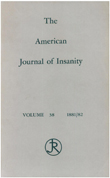[123I]beta-CIT SPECT imaging of striatal dopamine transporter binding in Tourette's disorder
Abstract
OBJECTIVE: The authors examined whether subjects with Tourette's disorder have greater than normal striatal dopamine transporter densities, as suggested by previous post-mortem findings. METHOD: Single photon emission computed tomography (SPECT) and [123I]2 beta- carbomethoxy-3 beta-(4-iodophenyl)tropane ([123I]beta-CIT) were used to assess dopamine transporter levels in five adult patients with Tourette's disorder and five age- and gender-matched healthy comparison subjects. RESULTS: Striatal [123I]beta-CIT binding was a mean of 37% (range = 6%-79%) higher in the subjects with Tourette's disorder than in the comparison subjects, and each Tourette's disorder patient had a higher level than his or her paired comparison subject. CONCLUSIONS: These findings corroborate post-mortem results and support the hypothesis of a dysregulation in presynaptic dopamine function in Tourette's disorder.
Access content
To read the fulltext, please use one of the options below to sign in or purchase access.- Personal login
- Institutional Login
- Sign in via OpenAthens
- Register for access
-
Please login/register if you wish to pair your device and check access availability.
Not a subscriber?
PsychiatryOnline subscription options offer access to the DSM-5 library, books, journals, CME, and patient resources. This all-in-one virtual library provides psychiatrists and mental health professionals with key resources for diagnosis, treatment, research, and professional development.
Need more help? PsychiatryOnline Customer Service may be reached by emailing [email protected] or by calling 800-368-5777 (in the U.S.) or 703-907-7322 (outside the U.S.).



